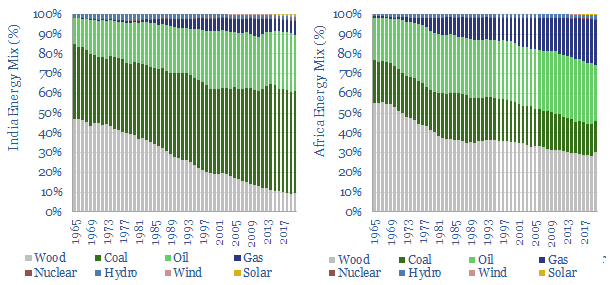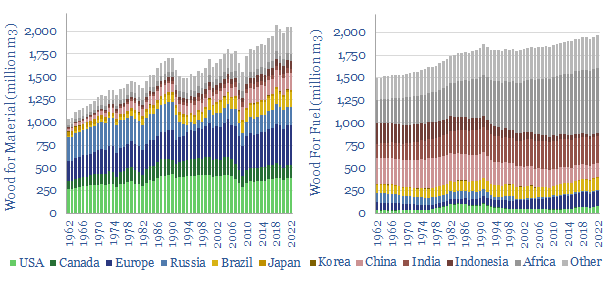This data-file quantifies global wood production, country-by-country, category-by-category, back to 1960, using granular data from the FAO. About 4bn m3 of wood are harvested per year (2GTpa by mass).
Global wood consumption has been quantified by the FAO at over 4bn m3 in 2022, another all time high, having risen at a 20-year CAGR of 0.7% per year.
The split is that 50% is used as fuel, 20% as paper/pulp and 30% as longer-lasting materials which may help remove CO2 from atmospheric circulation.
Fuel wood consumption has been quantified at 2bn m3 in 2022, equivalent to 1GTpa of wood, around 6,000 TWH of primary energy.
Wood consumption for fuel varies greatly by economic development levels. 85% of all wood burning for fuel occurs in the emerging world, of which 35% is Africa, c15% is India. Africa and India use 90% of their wood as fuel. The US and Europe use 20%.
Wood consumption for fuel tends to fall as countries industrialize. As Korea industrialized, wood use as fuel fell from 70% in 1960 to 7% in 2020.
Overall, wood energy has declined from 11% of the world’s primary energy mix in 1960 to c4% today. However, it remains stubbornly high in less developed countries (e.g., 30% in Africa, data below).

Deforestation remains the largest source of CO2 emissions globally, and the data suggest shortages of oil, gas and coal could exacerbate this ecological disaster. If coal, oil and gas prices all treble, then by extension, the relative value of wood-based fuels approximately trebles too (note here).
To read more about the global wood harvest and production, please see our article here. We think the CO2 credentials of wood in the energy transition range from -2.0 tons/ton to +2.0 tons/ton, depending heavily on context, but also creating opportunities (note here).
